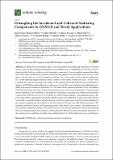Por favor, use este identificador para citar o enlazar a este item:
http://hdl.handle.net/10261/237565COMPARTIR / EXPORTAR:
 SHARE SHARE
 CORE
BASE CORE
BASE
|
|
| Visualizar otros formatos: MARC | Dublin Core | RDF | ORE | MODS | METS | DIDL | DATACITE | |

| Título: | Untangling the incoherent and coherent scattering components in GNSS-R and novel applications |
Autor: | Muñoz-Martín, Joan Francesc; Onrubia, Raul; Pascual, Daniel CSIC ORCID; Park, Hyuk; Camps, Adriano CSIC ORCID; Rüdiger, Christoph; Walker, Jeffrey; Monerris, A. CSIC ORCID | Palabras clave: | GNSS-R Incoherent scattering Sea Coherent scattering |
Fecha de publicación: | 2020 | Editor: | Multidisciplinary Digital Publishing Institute | Citación: | Remote Sensing 12(7): 1208 (2020) | Resumen: | As opposed to monostatic radars where incoherent backscattering dominates, in bistatic radars, such as Global Navigation Satellite Systems Reflectometry (GNSS-R), the forward scattered signals exhibit both an incoherent and a coherent component. Current models assume that either one or the other are dominant, and the calibration and geophysical parameter retrieval (e.g., wind speed, soil moisture, etc.) are developed accordingly. Even the presence of the coherent component of a GNSS reflected signal itself has been a matter of discussion in the last years. In this work, a method developed to separate the leakage of the direct signal in the reflected one is applied to a data set of GNSS-R signals collected over the ocean by the Microwave Interferometer Reflectometer (MIR) instrument, an airborne dual-band (L1/E1 and L5/E5a), multi-constellation (GPS and Galileo) GNSS-R instrument with two 19-elements antenna arrays with 4 beam-steered each. The presented results demonstrate the feasibility of the proposed technique to untangle the coherent and incoherent components from the total power waveform in GNSS reflected signals. This technique allows the processing of these components separately, which increases the calibration accuracy (as today both are mixed and processed together), allowing higher resolution applications since the spatial resolution of the coherent component is determined by the size of the first Fresnel zone (300–500 meters from a LEO satellite), and not by the size of the glistening zone (25 km from a LEO satellite). The identification of the coherent component enhances also the location of the specular reflection point by determining the peak maximum from this coherent component rather than the point of maximum derivative of the incoherent one, which is normally noisy and it is blurred by all the glistening zone contributions. | Descripción: | This article belongs to the Special Issue Applications of GNSS Reflectometry for Earth Observation. | Versión del editor: | https://doi.org/10.3390/rs12071208 | URI: | http://hdl.handle.net/10261/237565 | DOI: | 10.3390/rs12071208 | E-ISSN: | 2072-4292 |
| Aparece en las colecciones: | (ICE) Artículos |
Ficheros en este ítem:
| Fichero | Descripción | Tamaño | Formato | |
|---|---|---|---|---|
| untanappl.pdf | 1,62 MB | Adobe PDF |  Visualizar/Abrir |
CORE Recommender
SCOPUSTM
Citations
18
checked on 02-may-2024
WEB OF SCIENCETM
Citations
13
checked on 22-feb-2024
Page view(s)
86
checked on 07-may-2024
Download(s)
122
checked on 07-may-2024
Google ScholarTM
Check
Altmetric
Altmetric
Este item está licenciado bajo una Licencia Creative Commons

